You are using an out of date browser. It may not display this or other websites correctly.
You should upgrade or use an alternative browser.
You should upgrade or use an alternative browser.
Around Australia in a Land Rover
- Thread starter Iain_U1250
- Start date
Iain_U1250
Explorer
During our trip we kept writing down all the things that we needed to do differently on our Unimog, or just do differently. Each major trip we have done has shown us things that we have incorporate into the truck but being away for so long was a real eye opener.
On our previous trips or two or three weeks, we carried enough food to last the whole trip. We would also only be going to specific places, so it was easy to decide what extra gear like hiking boots, boats, snorkels etc to carry. On this trip we knew basically where we were going, but not what we were going to be doing. To that end we ended up carrying a lot more stuff than on any other trip. Space and weight became a real problem when we were packing, especially since we knew we were going down the Anne Beadell highway, where water was likely to be pretty scarce. We had a custom built water tank made, which fitted in the rear footwell. It would hold approximately 110lt. We carried a lot less food though, limiting ourselves to about a two week supply. We also had to be prepare for bad weather, so we had some extra things like a large tarp, our "tent room" add on for the awning.
This is a basic list of everything we carried:
Roof top tent including sheet, duvet, blanket and pillows ( and we had one extra change of bedding).
Clothes - mainly shorts and t-shirts, but some cold weather gear and rain gear as well.
Lounger (We planned on staying a place for a few days, so need somewhere for my wife to lie down during the day.)
Camp chairs
Aluminium side table
Shade cloth awning ( 3.6 x 6m) with 3 x poles.
Shade cloth groundsheet.
Wind break.
S/Steel Side table and a free standing table.
Two collapsible buckets for washing up.
15lt stainless steel bucket
Cups, plates and bowls ( x 4)
Cutlery, knives.
Frying pan, two small pots
Ecopot (has two large pots inside)
Inflatable boat and 2.4hp outboard, paddles, life jackets, flares etc, spare propeller and shear pins, outboard motor oil, (we planned on exploring Shark bay and a few lakes and rivers along the way.
Land Rover spare parts: Top and bottom radiator hoses, fan belt, oil, fuel (x 3) and air filters (x2), Shock rubbers, wheel bearing kits, collection of nuts, bolts and screws, fuses, wire, insulation tape, duct tape,"rescue tape" a metre of 13mm, 16mm and 19mm hose. R&R bead breaker and tyre patches and plugs.
Gas stove and 3kg gas bottle
85W solar panel
Tool kit (pretty comprehensive one)
Spare tent so we could camp on a island or next to a river/lake when using the boat overnight.
Photo Gear (we had 3 cameras,nine lenses, 12 memory card (total of 512GB of storage), seven batteries, two flashes, two portable hard disks for back-ups, a monopod and a tripod, a small camera bag and a large backpack.)
Go Pro and Contour video cameras and mounts etc.
Lap tops x 2
iPad
Garmin Rhino650 GPS radios x 2
Electric toothbrush and razor.
12V or 240v chargers for all electrical gear
Flippers and Snorkels x 2
Large first aid kit (including antibiotics and various other medicines)
Small first aid kit (for hiking)
Small back pack.
Hats - three each and we bought other ones on the way.
Shoes - We both had: Hiking boots, running shoes, two pairs of thongs, "reef shoes", "formal" shoes - Trish had a pair of high heels and another pair of "nice shoes"
Beach towels and micro fibre drying towels.
Barbeque grid
Rubber mat for standing on whilst showering
Camp shower
Metal detector
12V compressor
Large tarp
Room Tent for our awning
"Life Saver" Jerry Can - for producing clean water
"Life Saver" Bottle - for use on hikes and boating on lakes or rivers
25lt drinking water bottle
Nespresso machine and around 30 boxes of the capsules.
5lt of petrol for the outboard
Large LED torch, smaller LED torch, two LED head light torches.
LED lantern and a Fluro lantern - rechargeable
10lt of engine oil.
Brake fluid, diff oil, transfer case oil, ( one bottle of each)
3 x 20lt and 1 x 10lt diesel jerry cans ( we bought the three 20lt before starting the Anne Beadell highway)
"Mr Funnel" fuel filter funnel for use on any dodgy outback servos.
We had 10 "ammo cases" in total, three for clothes, three for food, one for all the spares and one for the Nespresso machine and coffee capsules, two high top ones held the gas bottle, gas hose etc and the other the funnel and spare hoses.
We decided to keep the clothes we brought down from the roof to a minimum. We bought two "hobo rolls" - these are great, they can store quite a few days clothing. We found that we needed different type of clothing for different areas. For me it was pretty simple, shorts and shirts, maybe long sleeves and long pants for areas of mosquitoes or sand flies. Trish needed different clothes for different areas. Dry area where we would be mainly driving, a bit of walking etc needed different clothes to places where we would be doing a lot of hiking and swimming, or when we were at the beach we needed different clothes. If we were going to "fancy" restaurants or hotels, then dresses were required. We only needed our warm clothes our at Steep Point and at Mt Kaputar, for most of the time they just stayed packed in a box on the roof.
One thing we learnt on our previous trips was that the best place for the food and cooking stuff was in the drawer system. I made it so that the stove would fit in the first compartment along with all the pots and the second compartment held all the plates, cups etc, and the food. The third section held all the tools and recovery gear.
We can honestly say that we used every bit of stuff at least once on our trip with one exception, we did not get to use the outboard motor as the weather was too bad to go out in a little boat when we were at Shark bay/Steep Point. We did get to use the boat a few times but with the paddles only and it was definitely worth bringing it as we got to go places that other people can't. We were also not on a time limit paying $20 per hour like a some places, so we would stay until sunset and not worry.
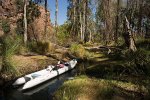
We found that there were three basic stages of unpacking. For a simple overnight stay when we were travelling, we would take out the chairs and the little table, the side table and the ground sheet. Everything else stayed in the car. This enable us to be ready for to cook or go to bed in about 10 minutes after stopping for the night, and we could pack up in about 20 minutes.
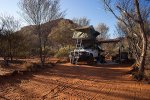
The gull wing windows were fantastic - it enabled easy access to the fridge on one side, and to all the other gear on the other side.
The next level of unpacking was if we were staying for just two nights.
Then we would take out the other table, the lounger and put out the awning for shade.
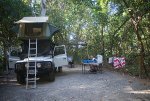
The final stage is when were staying at a place for a few days, like at Lawn Hill, or Mitchell Plateau or Bully's Camp, Cape Leveque. This is where we would get both awnings out if wee needed to, the shade cloth, tables and unpack some of the boxes. We would use these breaks to move food around from the boxes into the drawer, prepare meals in the Ecopot, change the clothes we kept in the "hobo rolls" and generally unpack a lot of stuff, sometime all the boxes and then re-pack the car.
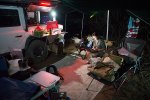
What we found was that it was easy to "make do" with less and things that were not easily accessible seldom got used. It was when we had the extra time to unpack more, then we found it much nicer, more comfortable and just better.
There are a few things that we now consider as "Essential" when are out in the bush.
One of the things we used a lot was our Garmin Rhino GPS radios. These are pretty nifty devices, they are a normal Garmin GPS system, with a 5w 80 channel two way radio with a built in. When set-up as a pair, the location of each radio is transmitted to each other. Most of the time, Trish and I were together, but occasionally I would wander off to take photos, and Trish could always see where I was.
When we were walking through the bush, We often wandered off the marked tracks, or went places where there were no tracks. Having the GPS meant we could always find out way back. It was pretty easy in the bush to get turned around and not be able to find the car or each other. Having two of them meant we had a back-up, but also a decent two way radios which we used on photo shoots if I was far away. They have a 16 hour battery life but do take a few hours to charge up. I got the 12v charger as well which makes it easier than using the inverter and more efficient.
The other thing we used all the time was the "Life Saver" bottle. This is a micro filtration system that can take almost any fresh water and make it safe to drink.
LIFESAVER bottle Australia
Michael Pritchard: How to make filthy water drinkable | Video on TED.com
If we were going bush walking to a waterfall or waterhole, we would take enough water for the walk in, a litre bottle each and the Lifesaver bottle, we could then fill up our water bottles from the river or water hole. This was very useful at Edith Falls, Mitchell Plateau and Lawn Hill, where the 5-10km walks take around 5-8 hours, and even if you start early, you end up walking in the hottest part of the day. It also meant we were carrying less weight - if you need four litres of water each, that is a pretty heavy load to carry, especially when you camera bag weighs 10kg by itself
When we were out on the boat, we could easily stay out the whole day on the river without having to carry loads of water. On Sir John Gorge at Mornington Wilderness camp, we were on the river by 9:00am and got back to camp around 6:30pm. It was pretty hot as well, but we always had enough water. Similarly at Lawn Hill gorge, we spent the whole day out on the river.
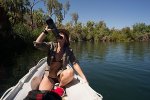
We have both the Lifesaver Bottle and the Lifesaver Jerry can. The Jerry can we use in place of buying bottled drinking water. We fill up from a tap, our water tank or from a river, and the water tastes so much better. In terms of "best water", The water from Lawn Hill and Katherine really tasted good. We filled up the Jerry can and used it to fill up our 25lt drinking water bottle as well. The main problem with using the Jerry can is the low flow rates, so we would use it to fill up our drinking water bottle, rather than pumping it each time.
One big lesson for us is that everything needs a place, and it needs to be put back there. We managed to "lose" a few key things inside the car by not putting them back where we got them. Then it is a case of almost unpacking the entire car to find them. We lost the 12 charger for the Garmin radios for two days, then the charger wire for the iPad. We ended up buying another iPad cable, both should have been in the pocket behind my seat with all the other chargers and wires, but they ended up under the centre console, right at the back.
Having to unpack things to get to other things becomes tedious. Our cups, plates and bowls were in the rear storage drawer along with the frying pan an the cutlery. To get a cup meant unpacking all the stuff on top, and then repacking to close the drawer - that is one thing that Trish insists on for our Unimog, things must be accessible.
There is another thing we learnt the hard way, things will leak, we had a can of Carnation milk spring a leak on the Anne Beadell highway. It took a lot of cleaning to get the smell out of the carpet that lined the drawers. Anything liquid ended had a plastic bag around it, just in case. Shampoo leaked, as did shower gel, the tooth pastes. We soon learnt to put all liquids in zip lock bags, including the eggs, as they were also prone to leaking.
When traveling for a long time, the little luxuries that we took for granted back at home, really became important. First off must be coffee, we took our Nespresso machine with us, and it was one of best things we did. Since unpacking it became a pain, we would set it up when parked for a while, and put 10 capsules of coffee into a flask. We needed to run the engine for this, as the power drain was too much for our dual battery system, but it was well worth it. We would love having a break in the morning around 10:00am with a large glass of cold coffee (Cold milk and a shot of coffee) and some fruit cake made in our Ecopot. Trish was never really awake without her morning coffee, we used the gas stove to heat up the milk and added a shot either from the Nespresso ( battery was good for one or two shots) or the flask we had done a day or two ago.
The other thing that we really enjoyed was showering. It was great to have enough water to have a proper shower, and something we did every night. Fitting the 110lt tank made a big difference, as we knew that we could use about 10-15 litres of water for a shower without having to worry. We found that most road houses had taps and hoses for filling up water tanks, and we would keep our tank topped up. We only filled up the water tank with clean water, no river water. We would fill up our medium size pot and heat it to almost boiling, then fill the camp shower with cold water, then add the hot water. The camp shower was basically a canvas bucket with a brass shower rose on the bottom. We hung it off two poles we stored on the roof rack. This worked very well, much better than the 12V shower we had previously. The rubber mat help keep the mud off your feet. It was great going to bed clean every night.
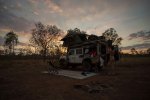
One of the most important things to get right is the tyre pressures. I ran 15 psi in the front and 22psi in the rear on most of the Anne Beadell and on Fraser island. The tyres look pretty flat, especially the rear ones. Here are the front ones on the barge - compare them to the Land Cruiser rears.
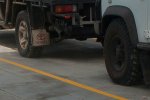
The rear ones are even flatter

Second is tyre size: This what having bigger tyres means - the extra 1" of clearance under the diff means I'm not dragging it through the sand like everyone else.
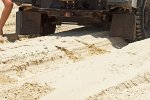
Getting the tyre pressure right on different roads is difficult. We had to replace two tyres because the got cut up so badly on the shale roads and because the left rear tyre got three punctures from sharp rocks all next to each other. There was still some life in the tyres, but since we still had 10,000km to go, and in some of the most remote places in Australia, we decided not to risk it.
We had a lot more weight up top for most of our trip
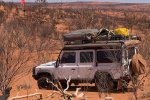
With that amount of weight, we had to drive to suit how top heavy we were. It does affect the car, and it took a day or two to get used to it, but you learn to compensate and become a lot more cautious as well. Having the roll cage meant we could carry more than a normal Land Rover on the roof, as the weight is transferred to the chassis. I would not recommend carrying that much without one, on our trip to Cape York, we had less weight on the roof, but ended up needing to get the roof repositioned as the front doors were hitting the "A" pillar by the end of the trip.
We carried a lot of recovery gear:
A pair of Maxtraxx,
Winch extension strap
Sheave block
Tree protector
Snatch Strap
Long handle shovel
We left behind things like the Tirfor hand winch and the hi-lift jack. These two item weight quite a bit and take up a lot of space. We did not have to use the recovery gear to get ourselves out of trouble. We did rescue a few other people though. We tackled some pretty "extreme" tracks as well, not the pure rock crawling, panel damaging ones, but we were the first vehicle up a new "road" at Lorella Springs, where we rock crawled up a creek bed for 500m, and a few others around there where if I got it wrong we would end up on our side. Some of the tracks at Arkaroola are pretty steep and rutted - first gear low range with Trish closing here eyes and wanting to get out and walk. We did not hold back, but were also conscious that we were very heavy, had a long way to travel and did not want to break anything. Slow and steady rather than charging up things. I don't believe in the "second gear low and go go go" philosophy that you see on some of the magazine and videos. Those guys break something on every trip. If they tried that on really remote area they would have some expensive recovery bills and fairly boring videos of them towing broken cars back to civilisation.
The Ashcroft ATB auto lockers worked great, getting up out of trouble on a few occasions when we had our front wheel a foot or so off the ground, and are fantastic in soft sand and bulldust. The 33" mud terrains are great, and one of the main reasons we made it through some places that other people did not, or were too afraid to go.
I'll post some more of what we learnt soon.
On our previous trips or two or three weeks, we carried enough food to last the whole trip. We would also only be going to specific places, so it was easy to decide what extra gear like hiking boots, boats, snorkels etc to carry. On this trip we knew basically where we were going, but not what we were going to be doing. To that end we ended up carrying a lot more stuff than on any other trip. Space and weight became a real problem when we were packing, especially since we knew we were going down the Anne Beadell highway, where water was likely to be pretty scarce. We had a custom built water tank made, which fitted in the rear footwell. It would hold approximately 110lt. We carried a lot less food though, limiting ourselves to about a two week supply. We also had to be prepare for bad weather, so we had some extra things like a large tarp, our "tent room" add on for the awning.
This is a basic list of everything we carried:
Roof top tent including sheet, duvet, blanket and pillows ( and we had one extra change of bedding).
Clothes - mainly shorts and t-shirts, but some cold weather gear and rain gear as well.
Lounger (We planned on staying a place for a few days, so need somewhere for my wife to lie down during the day.)
Camp chairs
Aluminium side table
Shade cloth awning ( 3.6 x 6m) with 3 x poles.
Shade cloth groundsheet.
Wind break.
S/Steel Side table and a free standing table.
Two collapsible buckets for washing up.
15lt stainless steel bucket
Cups, plates and bowls ( x 4)
Cutlery, knives.
Frying pan, two small pots
Ecopot (has two large pots inside)
Inflatable boat and 2.4hp outboard, paddles, life jackets, flares etc, spare propeller and shear pins, outboard motor oil, (we planned on exploring Shark bay and a few lakes and rivers along the way.
Land Rover spare parts: Top and bottom radiator hoses, fan belt, oil, fuel (x 3) and air filters (x2), Shock rubbers, wheel bearing kits, collection of nuts, bolts and screws, fuses, wire, insulation tape, duct tape,"rescue tape" a metre of 13mm, 16mm and 19mm hose. R&R bead breaker and tyre patches and plugs.
Gas stove and 3kg gas bottle
85W solar panel
Tool kit (pretty comprehensive one)
Spare tent so we could camp on a island or next to a river/lake when using the boat overnight.
Photo Gear (we had 3 cameras,nine lenses, 12 memory card (total of 512GB of storage), seven batteries, two flashes, two portable hard disks for back-ups, a monopod and a tripod, a small camera bag and a large backpack.)
Go Pro and Contour video cameras and mounts etc.
Lap tops x 2
iPad
Garmin Rhino650 GPS radios x 2
Electric toothbrush and razor.
12V or 240v chargers for all electrical gear
Flippers and Snorkels x 2
Large first aid kit (including antibiotics and various other medicines)
Small first aid kit (for hiking)
Small back pack.
Hats - three each and we bought other ones on the way.
Shoes - We both had: Hiking boots, running shoes, two pairs of thongs, "reef shoes", "formal" shoes - Trish had a pair of high heels and another pair of "nice shoes"
Beach towels and micro fibre drying towels.
Barbeque grid
Rubber mat for standing on whilst showering
Camp shower
Metal detector
12V compressor
Large tarp
Room Tent for our awning
"Life Saver" Jerry Can - for producing clean water
"Life Saver" Bottle - for use on hikes and boating on lakes or rivers
25lt drinking water bottle
Nespresso machine and around 30 boxes of the capsules.
5lt of petrol for the outboard
Large LED torch, smaller LED torch, two LED head light torches.
LED lantern and a Fluro lantern - rechargeable
10lt of engine oil.
Brake fluid, diff oil, transfer case oil, ( one bottle of each)
3 x 20lt and 1 x 10lt diesel jerry cans ( we bought the three 20lt before starting the Anne Beadell highway)
"Mr Funnel" fuel filter funnel for use on any dodgy outback servos.
We had 10 "ammo cases" in total, three for clothes, three for food, one for all the spares and one for the Nespresso machine and coffee capsules, two high top ones held the gas bottle, gas hose etc and the other the funnel and spare hoses.
We decided to keep the clothes we brought down from the roof to a minimum. We bought two "hobo rolls" - these are great, they can store quite a few days clothing. We found that we needed different type of clothing for different areas. For me it was pretty simple, shorts and shirts, maybe long sleeves and long pants for areas of mosquitoes or sand flies. Trish needed different clothes for different areas. Dry area where we would be mainly driving, a bit of walking etc needed different clothes to places where we would be doing a lot of hiking and swimming, or when we were at the beach we needed different clothes. If we were going to "fancy" restaurants or hotels, then dresses were required. We only needed our warm clothes our at Steep Point and at Mt Kaputar, for most of the time they just stayed packed in a box on the roof.
One thing we learnt on our previous trips was that the best place for the food and cooking stuff was in the drawer system. I made it so that the stove would fit in the first compartment along with all the pots and the second compartment held all the plates, cups etc, and the food. The third section held all the tools and recovery gear.
We can honestly say that we used every bit of stuff at least once on our trip with one exception, we did not get to use the outboard motor as the weather was too bad to go out in a little boat when we were at Shark bay/Steep Point. We did get to use the boat a few times but with the paddles only and it was definitely worth bringing it as we got to go places that other people can't. We were also not on a time limit paying $20 per hour like a some places, so we would stay until sunset and not worry.

We found that there were three basic stages of unpacking. For a simple overnight stay when we were travelling, we would take out the chairs and the little table, the side table and the ground sheet. Everything else stayed in the car. This enable us to be ready for to cook or go to bed in about 10 minutes after stopping for the night, and we could pack up in about 20 minutes.

The gull wing windows were fantastic - it enabled easy access to the fridge on one side, and to all the other gear on the other side.
The next level of unpacking was if we were staying for just two nights.
Then we would take out the other table, the lounger and put out the awning for shade.

The final stage is when were staying at a place for a few days, like at Lawn Hill, or Mitchell Plateau or Bully's Camp, Cape Leveque. This is where we would get both awnings out if wee needed to, the shade cloth, tables and unpack some of the boxes. We would use these breaks to move food around from the boxes into the drawer, prepare meals in the Ecopot, change the clothes we kept in the "hobo rolls" and generally unpack a lot of stuff, sometime all the boxes and then re-pack the car.

What we found was that it was easy to "make do" with less and things that were not easily accessible seldom got used. It was when we had the extra time to unpack more, then we found it much nicer, more comfortable and just better.
There are a few things that we now consider as "Essential" when are out in the bush.
One of the things we used a lot was our Garmin Rhino GPS radios. These are pretty nifty devices, they are a normal Garmin GPS system, with a 5w 80 channel two way radio with a built in. When set-up as a pair, the location of each radio is transmitted to each other. Most of the time, Trish and I were together, but occasionally I would wander off to take photos, and Trish could always see where I was.
When we were walking through the bush, We often wandered off the marked tracks, or went places where there were no tracks. Having the GPS meant we could always find out way back. It was pretty easy in the bush to get turned around and not be able to find the car or each other. Having two of them meant we had a back-up, but also a decent two way radios which we used on photo shoots if I was far away. They have a 16 hour battery life but do take a few hours to charge up. I got the 12v charger as well which makes it easier than using the inverter and more efficient.
The other thing we used all the time was the "Life Saver" bottle. This is a micro filtration system that can take almost any fresh water and make it safe to drink.
LIFESAVER bottle Australia
Michael Pritchard: How to make filthy water drinkable | Video on TED.com
If we were going bush walking to a waterfall or waterhole, we would take enough water for the walk in, a litre bottle each and the Lifesaver bottle, we could then fill up our water bottles from the river or water hole. This was very useful at Edith Falls, Mitchell Plateau and Lawn Hill, where the 5-10km walks take around 5-8 hours, and even if you start early, you end up walking in the hottest part of the day. It also meant we were carrying less weight - if you need four litres of water each, that is a pretty heavy load to carry, especially when you camera bag weighs 10kg by itself
When we were out on the boat, we could easily stay out the whole day on the river without having to carry loads of water. On Sir John Gorge at Mornington Wilderness camp, we were on the river by 9:00am and got back to camp around 6:30pm. It was pretty hot as well, but we always had enough water. Similarly at Lawn Hill gorge, we spent the whole day out on the river.

We have both the Lifesaver Bottle and the Lifesaver Jerry can. The Jerry can we use in place of buying bottled drinking water. We fill up from a tap, our water tank or from a river, and the water tastes so much better. In terms of "best water", The water from Lawn Hill and Katherine really tasted good. We filled up the Jerry can and used it to fill up our 25lt drinking water bottle as well. The main problem with using the Jerry can is the low flow rates, so we would use it to fill up our drinking water bottle, rather than pumping it each time.
One big lesson for us is that everything needs a place, and it needs to be put back there. We managed to "lose" a few key things inside the car by not putting them back where we got them. Then it is a case of almost unpacking the entire car to find them. We lost the 12 charger for the Garmin radios for two days, then the charger wire for the iPad. We ended up buying another iPad cable, both should have been in the pocket behind my seat with all the other chargers and wires, but they ended up under the centre console, right at the back.
Having to unpack things to get to other things becomes tedious. Our cups, plates and bowls were in the rear storage drawer along with the frying pan an the cutlery. To get a cup meant unpacking all the stuff on top, and then repacking to close the drawer - that is one thing that Trish insists on for our Unimog, things must be accessible.
There is another thing we learnt the hard way, things will leak, we had a can of Carnation milk spring a leak on the Anne Beadell highway. It took a lot of cleaning to get the smell out of the carpet that lined the drawers. Anything liquid ended had a plastic bag around it, just in case. Shampoo leaked, as did shower gel, the tooth pastes. We soon learnt to put all liquids in zip lock bags, including the eggs, as they were also prone to leaking.
When traveling for a long time, the little luxuries that we took for granted back at home, really became important. First off must be coffee, we took our Nespresso machine with us, and it was one of best things we did. Since unpacking it became a pain, we would set it up when parked for a while, and put 10 capsules of coffee into a flask. We needed to run the engine for this, as the power drain was too much for our dual battery system, but it was well worth it. We would love having a break in the morning around 10:00am with a large glass of cold coffee (Cold milk and a shot of coffee) and some fruit cake made in our Ecopot. Trish was never really awake without her morning coffee, we used the gas stove to heat up the milk and added a shot either from the Nespresso ( battery was good for one or two shots) or the flask we had done a day or two ago.
The other thing that we really enjoyed was showering. It was great to have enough water to have a proper shower, and something we did every night. Fitting the 110lt tank made a big difference, as we knew that we could use about 10-15 litres of water for a shower without having to worry. We found that most road houses had taps and hoses for filling up water tanks, and we would keep our tank topped up. We only filled up the water tank with clean water, no river water. We would fill up our medium size pot and heat it to almost boiling, then fill the camp shower with cold water, then add the hot water. The camp shower was basically a canvas bucket with a brass shower rose on the bottom. We hung it off two poles we stored on the roof rack. This worked very well, much better than the 12V shower we had previously. The rubber mat help keep the mud off your feet. It was great going to bed clean every night.

One of the most important things to get right is the tyre pressures. I ran 15 psi in the front and 22psi in the rear on most of the Anne Beadell and on Fraser island. The tyres look pretty flat, especially the rear ones. Here are the front ones on the barge - compare them to the Land Cruiser rears.

The rear ones are even flatter

Second is tyre size: This what having bigger tyres means - the extra 1" of clearance under the diff means I'm not dragging it through the sand like everyone else.

Getting the tyre pressure right on different roads is difficult. We had to replace two tyres because the got cut up so badly on the shale roads and because the left rear tyre got three punctures from sharp rocks all next to each other. There was still some life in the tyres, but since we still had 10,000km to go, and in some of the most remote places in Australia, we decided not to risk it.
We had a lot more weight up top for most of our trip

With that amount of weight, we had to drive to suit how top heavy we were. It does affect the car, and it took a day or two to get used to it, but you learn to compensate and become a lot more cautious as well. Having the roll cage meant we could carry more than a normal Land Rover on the roof, as the weight is transferred to the chassis. I would not recommend carrying that much without one, on our trip to Cape York, we had less weight on the roof, but ended up needing to get the roof repositioned as the front doors were hitting the "A" pillar by the end of the trip.
We carried a lot of recovery gear:
A pair of Maxtraxx,
Winch extension strap
Sheave block
Tree protector
Snatch Strap
Long handle shovel
We left behind things like the Tirfor hand winch and the hi-lift jack. These two item weight quite a bit and take up a lot of space. We did not have to use the recovery gear to get ourselves out of trouble. We did rescue a few other people though. We tackled some pretty "extreme" tracks as well, not the pure rock crawling, panel damaging ones, but we were the first vehicle up a new "road" at Lorella Springs, where we rock crawled up a creek bed for 500m, and a few others around there where if I got it wrong we would end up on our side. Some of the tracks at Arkaroola are pretty steep and rutted - first gear low range with Trish closing here eyes and wanting to get out and walk. We did not hold back, but were also conscious that we were very heavy, had a long way to travel and did not want to break anything. Slow and steady rather than charging up things. I don't believe in the "second gear low and go go go" philosophy that you see on some of the magazine and videos. Those guys break something on every trip. If they tried that on really remote area they would have some expensive recovery bills and fairly boring videos of them towing broken cars back to civilisation.
The Ashcroft ATB auto lockers worked great, getting up out of trouble on a few occasions when we had our front wheel a foot or so off the ground, and are fantastic in soft sand and bulldust. The 33" mud terrains are great, and one of the main reasons we made it through some places that other people did not, or were too afraid to go.
I'll post some more of what we learnt soon.
Last edited:
graynomad
Photographer, traveller
We had the same problem in Broome, two tyres with the steel showing (courtesy mostly of the Port Warender track, north of Mitchell falls) but otherwise good tread and I was loath to ditch them. I had two spare wheels but we were heading for the Gunbarrel, not a good place to be caught with nothing if the bad ones both blew.We had to replace two tyres because the got cut up so badly ... There was still some life in the tyres, but since we still had 10,,000km to go, and in some the most remote places in Australia, we decided not to risk it.
So I bought two more tyres and strapped them to the roof. As it turned out I got maybe 5000k more from the bad ones across the Gunbarrel, Central Hwy, Finke railway track, Simpson etc. One finally failed near Betoota and the other at Quilpie so I didn't really need the extra two tyres, but it was good to have them and saved me from buying tyres until I got back east.
Iain_U1250
Explorer
I would have loved to take the tyre back home with me, but weight and space did not allow it. If they were the $1100 Unimog tyres, then I would definitely take them back with me, and put lots of patches on them 
graynomad
Photographer, traveller
It was rough and remote enough a few years ago, must have been like the other side of the moon then.30 years ago since I've been there
HumphreyBear
Adventurer
Great post Iain, thanks for the trip report and the great detailed summary.
x2 on the details on the boat. How small does it pack down to?
Cheers,
Humph.
x2 on the details on the boat. How small does it pack down to?
Cheers,
Humph.
Iain_U1250
Explorer
It is a Grand Argus 550P
http://www.grandboats.com/argus.htm
It packs down to 100cm x 55cm x 35cm. We got the biggest one, but we actually wanted the 450P, the next size down, but they were out of stock. In hindsight, we are glad we got the bigger one as we have had four people in it, and carried our big tent and loads of gear, and most of all Trish can lie down flat in the boat and tan whilst I steer . It weighs 35kg, with the problems Trish has now, she can't help me carry it when it is inflated, so I've bought some wheels that go on the transom to help move it around. It takes us about 5 minutes to pump up with the foot pump, and about 5 minutes to pack away. We also have a set of oars for it, which are OK, but the twin blade paddles work better.
. It weighs 35kg, with the problems Trish has now, she can't help me carry it when it is inflated, so I've bought some wheels that go on the transom to help move it around. It takes us about 5 minutes to pump up with the foot pump, and about 5 minutes to pack away. We also have a set of oars for it, which are OK, but the twin blade paddles work better.
The little Honda 2.3hp four stroke motor is great, runs for about an hour on 1 litre of fuel, has a centrifugal clutch, so very each to use. We have had it up to 15kph on flat water.
http://marine.honda.com/outboards/motor-detail/BF2.3
It weights only 14kg. The motor can store flat, unlike others and is pretty compact, we carry it in a canvas bag on the roof.
http://www.grandboats.com/argus.htm
It packs down to 100cm x 55cm x 35cm. We got the biggest one, but we actually wanted the 450P, the next size down, but they were out of stock. In hindsight, we are glad we got the bigger one as we have had four people in it, and carried our big tent and loads of gear, and most of all Trish can lie down flat in the boat and tan whilst I steer
The little Honda 2.3hp four stroke motor is great, runs for about an hour on 1 litre of fuel, has a centrifugal clutch, so very each to use. We have had it up to 15kph on flat water.
http://marine.honda.com/outboards/motor-detail/BF2.3
It weights only 14kg. The motor can store flat, unlike others and is pretty compact, we carry it in a canvas bag on the roof.
Last edited:
thanks for that, seems to pack down into a nice small package. we've got one of these http://www.point65.com/kategori/5054/martini-tandem.html and while it's very versatile it's tough to pack in the back of the camper :Wow1:
graynomad
Photographer, traveller
I love that inflatable and small outboard Iain, I've been thinking about paddling down the Murray and that could be just the thing. I have done some of it in a canoe but I would need something that could be transported inside a camper van.
And that Martini Tandem is just weird
And that Martini Tandem is just weird
westyss
Explorer
Really enjoyed reading this trip report and great pictures! Thanks.
It was interesting to see the inflatable pontoon kayak too, I have recently just purchased one that was similar to yours and even thought it was the same one but is not, this is the one I got http://www.seaeagle.com/PaddleSki.aspx I have a little 2 horse honda for it. I have not recieved it yet so have no comments on it but it was good to hear that you used yours and like it as it is an experiment for us.
It was interesting to see the inflatable pontoon kayak too, I have recently just purchased one that was similar to yours and even thought it was the same one but is not, this is the one I got http://www.seaeagle.com/PaddleSki.aspx I have a little 2 horse honda for it. I have not recieved it yet so have no comments on it but it was good to hear that you used yours and like it as it is an experiment for us.
Iain_U1250
Explorer
It was great having a boat on our trip, whilst there were places that hire canoes out, having your own boat means not having deadlines and you can take your time.
The one major thing we wanted to do was to go to Dirk Hartog island from Steep Point, but it was very windy and our boat is more for rivers and lakes than rough seas. If Shark bay was calm, like it was when I was last there a few years ago, we would have taken our boat out, but it is a bit long for windy days.
The one major thing we wanted to do was to go to Dirk Hartog island from Steep Point, but it was very windy and our boat is more for rivers and lakes than rough seas. If Shark bay was calm, like it was when I was last there a few years ago, we would have taken our boat out, but it is a bit long for windy days.
Similar threads
- Replies
- 8
- Views
- 970
- Replies
- 6
- Views
- 1K
- Replies
- 2
- Views
- 773
- Replies
- 15
- Views
- 3K
